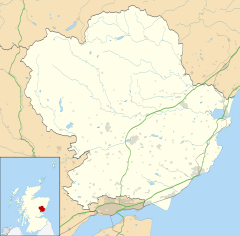Inverpeffer (Scottish Gaelic: Inbhir Pheofhair, lit. 'Mouth of the shining/beautiful stream') was a hamlet that once existed in Angus, Scotland until around 1941, when it was demolished during the building of East Haven airfield.[1]
Inverpeffer
| |
|---|---|
Location within Angus | |
| OS grid reference | NO599379 |
| Council area | |
| Lieutenancy area | |
| Country | Scotland |
| Sovereign state | United Kingdom |
| Police | Scotland |
| Fire | Scottish |
| Ambulance | Scottish |
David of Inverpeffer was one of the signatories to the Performance of Fealty to Edward I, signed in August 1296 at Berwick upon Tweed.[2]
It was on a return journey from Inverpeffer to Barry in 1797 that loomwright Thomas Lowson fell asleep in grassland belonging to Major William Phillips. Lowson, enamoured of the area, approached Phillips, securing a feu of land, and built the first house in the village that was to become Carnoustie.[3]
Today, a single building from the former hamlet remains.
References
edit- ^ "Inverpeffer", Canmore Database, Historic Environment Scotland, retrieved 21 April 2023
- ^ "Performance of fealty to Edward I, king of England", People of Medieval Scotland, retrieved 21 April 2023
- ^ Dickson, R. (1892), Carnoustie and its Neighbourhood (revised ed.), Balgavies, Angus: Pinkfoot Press (2002 facsimile)
